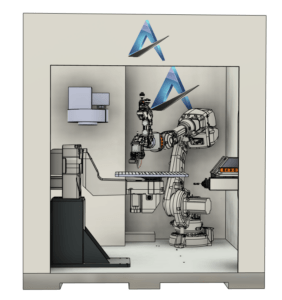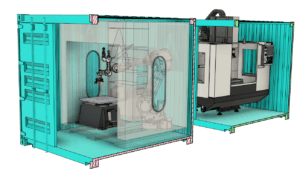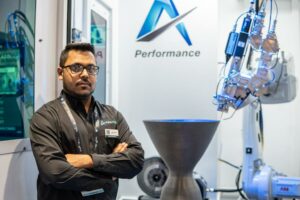Welcome to the Future of Deployable On-Demand Manufacturing
Hybrid DED systems will advance and modernize manufacturing to quickly pivot and respond to demands.
Posted: August 15, 2023
 The recent pandemic was a true black swan event in that it shocked a lot of seemingly robust systems. This shock shattered the fragile supply chains of various manufacturing industries and even caused the halting of production lines in some cases. While normalcy is returning slowly, the industries have started reassessing their in-house manufacturing capabilities and are exploring various avenues to meet their needs. Additive manufacturing (AM) can be of great help in this regard as it offers true design freedom free of conventional constraints, part count reduction through design consolidation and most importantly, on-demand manufacturing.
The recent pandemic was a true black swan event in that it shocked a lot of seemingly robust systems. This shock shattered the fragile supply chains of various manufacturing industries and even caused the halting of production lines in some cases. While normalcy is returning slowly, the industries have started reassessing their in-house manufacturing capabilities and are exploring various avenues to meet their needs. Additive manufacturing (AM) can be of great help in this regard as it offers true design freedom free of conventional constraints, part count reduction through design consolidation and most importantly, on-demand manufacturing.
In the world of structures, metals and their alloys play a very indispensable role. Although there are multiple implementations to 3D print metal parts, there are limited cost-effective metal AM systems in the market which can print metal parts on-demand at scale while not compromising productivity and resolution. To address this need, ADDiTEC offers a performance line of metal AM systems featuring a powerful 6 kW single fiber laser deposition head. The deposition heads work based on the principle of laser-wire Directed Energy Deposition (DED) where weld beads are precisely stacked according to CAD to create a 3D structure. The weld bead is created when wire is introduced into the laser generated melt pool. The deposition heads are mounted to commercially available robotic arms for producing highly complex parts with infinite degrees of freedom with no inherent constraints when the working envelope is only limited by the size of the motion system and enclosure.
Portable Performance AM System
 After printing, the component can directly undergo machining or surface treatment along with heat treatment to create high precision fits with required mechanical properties. Typical bead widths for wire correspond to 1.2x the wire diameter, representing the lower wall thickness limit for wire 3D printing. The system can process standard MIG filler materials, ensuring excellent availability and low material prices globally. Typical layer heights range from 0.3-to- 1.2 mm and can be selected depending on the required surface finish and printing time.
After printing, the component can directly undergo machining or surface treatment along with heat treatment to create high precision fits with required mechanical properties. Typical bead widths for wire correspond to 1.2x the wire diameter, representing the lower wall thickness limit for wire 3D printing. The system can process standard MIG filler materials, ensuring excellent availability and low material prices globally. Typical layer heights range from 0.3-to- 1.2 mm and can be selected depending on the required surface finish and printing time.
Some salient features of this metal AM system:
- Material feedstock being wire, it is safe and cost-effective.
- No wire feedstock is wasted as all the wire enters the melt pool.
- Ability to print aluminum, copper, stainless steels, mild steel, carbon steels, Inconel and titanium alloys.
- Up to 4 kg/hr. deposition rate.
- As the heat affected zone is compact by virtue of the deposition technology, the printed parts have good surface finish, excellent strength, and exhibit near isotropic properties.
- Pyrometer data based closed loop control system for regulating melt pool temperature and wire feed rate.
- Sophisticated wire feed system with wire straightener for precise deposition.

To enhance mission-readiness through cost-effective production of products which are on-demand and point-of-need, either at the base, at sea, or on the frontlines, we have envisioned architectures for robotic hybrid manufacturing portable cells rated for conventional, reactive and refractory alloys. The portable cells provide all the benefits of a robotic architecture for additive and subtractive manufacturing in a compact hermetically sealed cell that is portable, allowing installation and the first printed parts in just one day making forward-deployable on-demand manufacturing a reality.
While robotic DED is scalable to very large sizes, it results in parts that are rough, near net shapes requiring post fabrication machining. Up to this point, parts are “printed” and then taken to machine shops for machining part features such as axle bores, threaded holes, etc. This post fabrication machining step is also used to reduce or eliminate surface roughness that results from the DED stacking of weld bead like layers during the build. For some potential applications of large-scale metals DED, the post fabrication machining step is logistically cumbersome and slows the overall process. Furthermore, some parts may have internal features such as flow passages, for example, that cannot be machined after the total part build is completed because cutting tool access is not available. These issues lead to the notion of hybrid manufacturing where additive and subtractive processes are operationally integrated into an in-situ iterative process. The three configurations are illustrated in the Figures:
- Figure 1: Highlights a single 40-foot Conex, equipped with portable robotic AM cell by ADDiTEC, CNC Mill (HAAS TM1), and heat treatment furnace.
- Figure 2: Highlights a 20-foot Conex, equipped with portable robotic AM cell by ADDiTEC and second 20-foot cones with hybrid CNC Mill (HAAS TM1), with a 9 Technology Readiness Level and 5 Manufacturing Readiness Level.
- Figure 3: Highlights portable robotic hybrid cell by ADDiTEC with additive and subtractive capabilities with an automatic tool changer. This innovative solution combines cutting-edge technology and portability to transform the additive manufacturing industry, eliminating logistical challenges associated with traditional additive and subtractive manufacturing setups while maintaining superior quality standards.
The hybrid DED systems can deliver on multiple fronts such as mobility, ruggedness, speed, reliability, ease of use and material readiness of “point-of-need” manufacturing. The system will advance and modernize manufacturing to quickly pivot and respond to demands. Establishing this deployable hybrid manufacturing capability will greatly improve self-reliance and better ensure optimal readiness for emergencies.
Subscribe to learn the latest in manufacturing.








